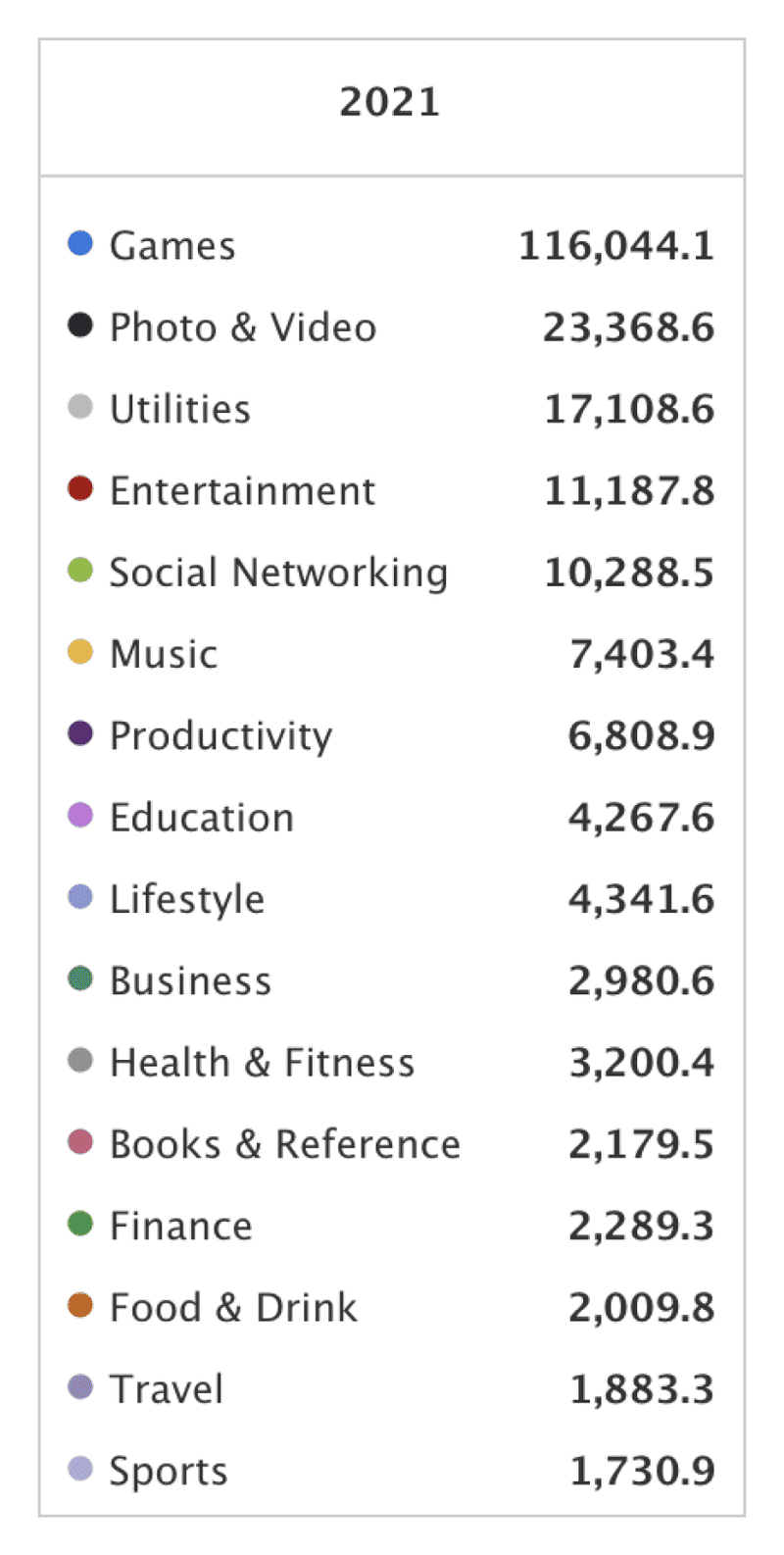How much money can an app make you in 2022?
The mobile app industry has been active for over a decade, generating billions of dollars in revenue for Apple, Google, and thousands of mobile app developers. The tech giants didn't add an app store to the first versions of iOS and Android because they didn't initially think it was necessary, but over time it has become a major source of revenue for both.
The mobile application market is growing exponentially. This huge industry is developing day by day and seems to never stop. The army of developers is constantly increasing, and the number of apps is rising accordingly. Undoubtedly, the revenue generated by the mobile application industry is above all records. This trend has led many start-ups and business owners to move to mobile and release their own apps to make more money. But can you actually make money with mobile apps, and how does it work exactly? Let’s clear this up together.
Market overview
Given the considerate growth of technology in our lives, smartphones began to be an indispensable tool in our day-to-day lives. To understand the number of people who own a smartphone, let's take a look at the latest smartphone user statistics.

According to Statista, there are currently 6.648 billion smartphone users, which means that 83.96% of the world's population owns smartphones. This number is significantly higher than in 2016 when it had 3,668 million users, which was 49.40% of the world's population that year. These numbers only prove the fact that people around the world recognize the benefits of these devices, and, at the same time, companies try to take advantage of this opportunity, which unlocks the ability to reach a huge scale of customers, globally.
According to a survey, the average American checks the phone 262 times a day. This is once every 5.5 minutes. We use mobile phones at work, at home, on the street, while eating, in bed, and even in the car. You even may be reading this on your mobile device. What is everyone doing on their cell phone? Well, 88% of mobile time is spent on apps.
Everywhere we turn these days, every organization, business, and brand seems to have an app. Downloaded by users around the world, these small but nifty programs offer everything from daily mobile phone updates to smooth purchasing channels.
In 2008, the iOS App Store launched with 500 apps. Currently, the market has developed, and users can choose from a variety of 1.85 million different apps to download. Android users have even more choices, with 2.56 million available from the Google Play store. Through them, we can access music libraries around the world, build relationships, manage schedules, documents, and payments. Augmented reality apps are changing the way we interact with the world, and mobile games are one of the most popular types of entertainment today. Apps also played a huge role during the COVID 19 pandemic that shaped 2020 and facilitated social distancing. Not to mention the important role they played in keeping in touch with friends, family, and colleagues, and continuing our professional life.
App download data
Growing hand-in-hand with the number of smartphone users worldwide is the number of app downloads. As described in SensorTower, in 2020 alone, the number of app downloads reached a whopping 143 billion across the two most influential platforms (App Store and Google Play), and is projected to reach 230 billion by 2025. The choice of platform can have a significant impact on revenue potential due to differences in market share, purchasing power, and overall popularity of the platform. iOS accounts for about 24% of the global market and Android accounts for more than 76%.
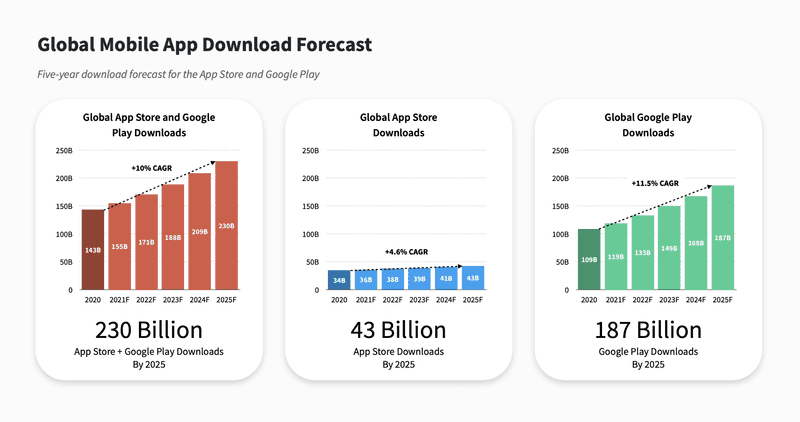
However, if you look at each region individually, things change dramatically. For example, users in the US, Canada, Australia, Japan, and Scandinavian countries prefer iOS, while users in Eastern Europe, some Western European countries, South America, Africa, and most Asian countries tend to choose Android devices.
According to Sensor Tower, the App Store is expected to have the highest growth rates in Africa, North America, Australia, and Europe. These statistics show that if you are interested in iOS apps, you should consider these regions for your target audience.
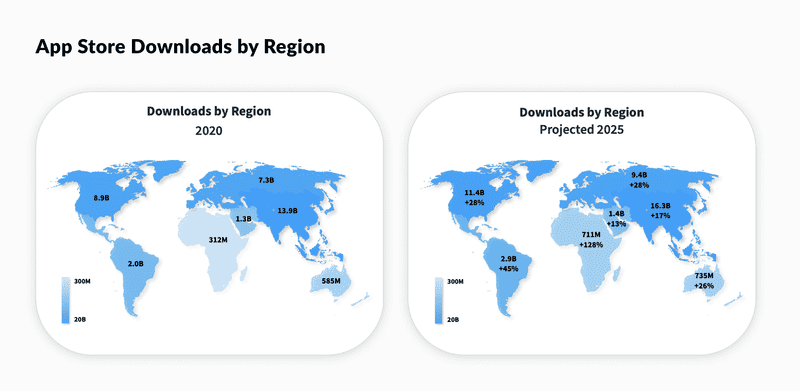
On the other side of the coin, looking at the growth rate of Google Play, the highest growth rate is predicted in Latin America, Asia, and The Middle East.
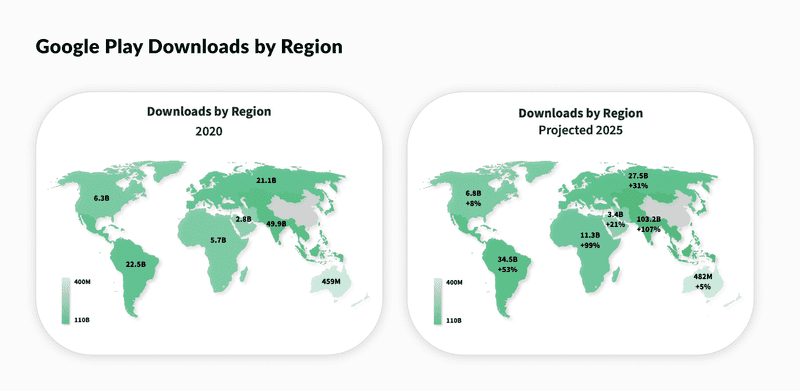
|
Source: Statista
|
Another important dimension that must be talked about in this context is the app categories. As you can see in the data provided by Statista, the Game apps category is the undisputed leader when it comes to downloads and it doesn’t look like the growth is going to stop, estimated to reach more than 165 billion downloads per year by 2025. When analyzing the data broken down into categories, it is obvious that there is a dominance of leisure and lifestyle app downloads compared to work and business-related ones. |
There is an app for every possible use scenario, but behind every app, there is a team of people that have to generate revenue via these programs. So, how much money can an app generate?
App revenue data
Mobile apps can generate billions of dollars in revenue each year. However, there are only a few apps that manage to do this. The vast majority of apps literally make no money at all. Therefore, there are a huge number of apps out there and there are incredible fluctuations in the amount of revenue that developers can generate. Let’s understand this through the pattern of the current revenue potential of industry-leading apps.
The apps that rank in the top 200 of the App Store generate about $82,500 in revenue per day. If you extend that bracket a bit and look at the revenues of the top 800 apps, the daily revenue will drop to about $3,500. This difference extends to categories as well. Looking at gaming apps, the output reaches about $22,000 a day, while entertainment apps generate just $3,090 a day, which is significantly lower. However, there is no one-size-fits-all answer as to how much money an app can make.
In 2018, global mobile app developers’ revenues amounted to over $365 billion. In 2023, mobile apps are projected to generate more than $935 billion in revenues via paid downloads, subscriptions, and in-app advertising. The top-grossing mobile app developers worldwide in January 2019 had over $40 million in-app revenues each.
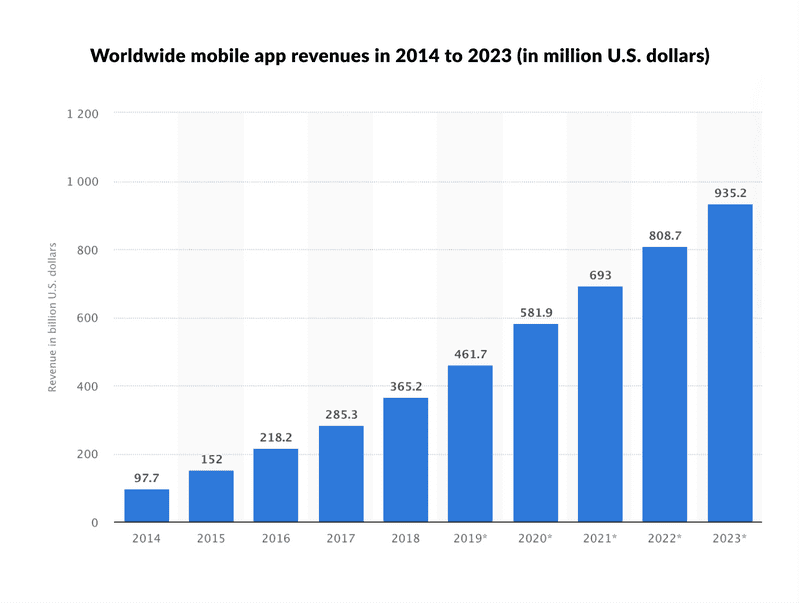
This huge revenue generation is a by-product of increased mobile phone usage, as 52.2% of global traffic comes from mobile phones. For companies, this is a gold mine that can lead to massive growth, and industry leaders are already beginning to use this platform to generate a higher return on investment.
What platform have higher revenue generation?
If we look at the consumer spending on the Play Store and App Store, excluding third-party revenue streams like in-app advertisements, the overall revenues drop significantly, with the projected returns on both platforms for 2025 reaching $270 billion. This highlights the power of advertising revenues.
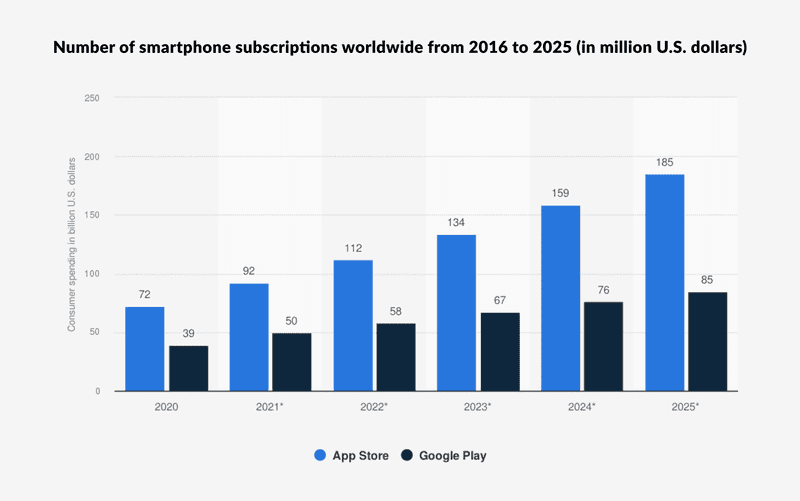
One crucial thing to take into consideration when choosing an app is the purchasing power of the two platforms’ consumers. Even though the number of downloads on the Google Play Store is significantly higher, iOS apps manage to generate much more revenue, with a higher expected annual growth rate (20,7% per year on iOS in respect to 16,9% per year on Android).
According to Slickdeals, iPhone owners make more money than Android users, and as a result, App Store users spend twice as much as Google Play users. According to this survey, Android users are generally more prudent than iPhone users and are trying to save money when shopping. On the other hand, iPhone users tend to spend a lot on things related to self-image, especially clothing and cosmetics. This study suggests that Android users aren't as tied to their phones as iPhone users, except that they are very money conscious.
Worldwide revenue hotspots
Since Asia has the highest density population on earth that equates to the highest number of smartphone users, for both Google Play and the App store, it is the biggest revenue generator globally. The regions that occupy second and third place in this list are Europe and North America
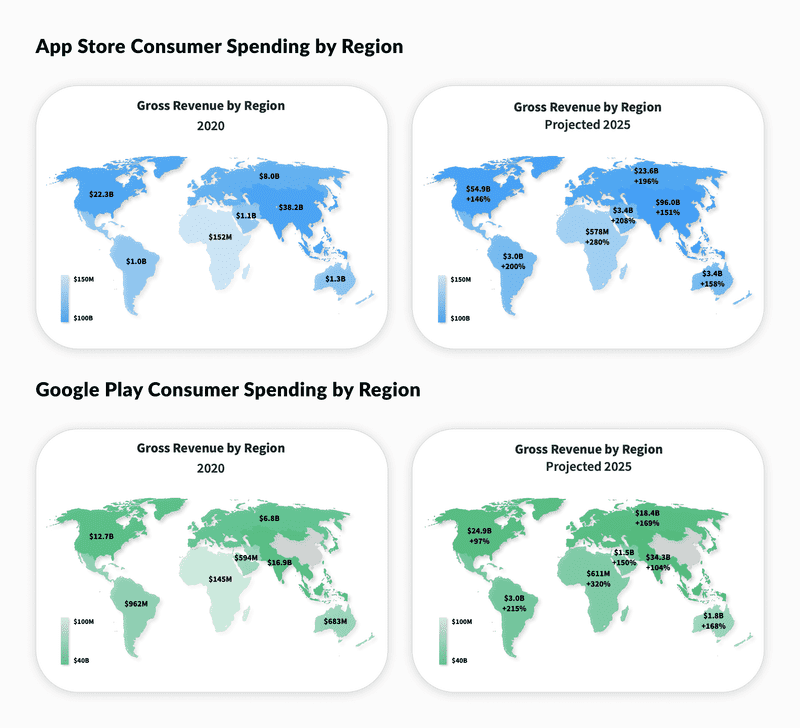
Europe is an important region to watch for the next five years. Its projected revenue growth is higher than that of North America and Asia, with an annual growth rate of 23% over the next five years in Europe, 20% in Asia, and 18% in North America. As a result, user spending in Europe will reach $ 42 billion by 2025.
While app adoption has slowed in some mature markets, mobile spending continues to grow. Downloads in North America are projected to increase at a compound annual growth rate of only 3.6% over the next five years, while sales are anticipated to rise at an annual growth rate of almost 18%.
Top performing countries
The United States outperformed China in App Store revenue in the second quarter of 2020 and for the first time since the fourth quarter of 2018. US revenue surged, especially with mobile games, after COVID-19 became widespread in early 2020. Similar growth is expected in both countries over the next five years. The top three countries on the App Store are far ahead of the rest for the time being

Google Play revenue growth in the US and Japan accelerated in 2020. Mobile game spending remained high in 2021 as consumers continue to spend more time at home during COVID-19. The UK has the highest projected sales annual growth rate of 22% of the top five countries, followed by Germany at 19%.
The United States remains the top market on both platforms, with a compound annual growth rate of 20% on the App Store and 14% on Google Play.
App revenue models
After reviewing the global regions of interest, and the differences between the two most influential platforms, it’s time to talk about the ways an app can make money. Besides choosing an app platform, it's important to consider the monetization model to use. The good news is that you don't have to reinvent the wheel. With millions of apps, the most effective monetization models are already known and tested.
By starting with a well-known model, you can leverage the experience of other successful companies in determining the best monetization model for your app. After starting with a familiar model, you can continue experimenting with different models as needed.
To better understand the most common revenue models, let's first classify all models into three categories.
- Free apps: Apps in this category do not contain paid content. The free app can be downloaded and used for free.
- Partially Free: This is currently the most popular monetization model (Freemium). These apps are free to download, but the app limits user functionality. Users must pay to be able to use all the features of the app.
- Paid apps: Unless you have a free trial period, paid apps require payment to download the app. However, after the trial period ends, users will have to pay to continue using the app.
- Subscription apps: It is usually free to download but requires customers to pay a recurring fee for access to the application’s services.
Next, let's see how you can make money with each payment model.
Free apps
Is there such a thing? Yes, free apps can generate money. The answer is in-app advertising, also known as affiliate marketing. Developers that use this kind of monetization make money based on user interaction with the ads displayed in the app. Remember that you need a lot of downloads to profit from a free app. Some of the most popular types of affiliate marketing campaigns are:
- Pay-per-click (CPC): You pay for each click on the ad that appears in your app. However, since there are no clicks, revenue from these campaigns is calculated on a cost per 1000 basis.
- Cost per View (CPW): The more people you see your ad, the more money you can earn. This type of campaign typically uses video ads.
- Cost per installation (CPI): Developers are paid when the users install the promoted app.
The main advantage of free app monetization strategies is the variety of ad formats that allow you to choose the one that best suits your needs. First, you can choose your ad format based on the criteria that best suit you, such as price and level of user interaction. This approach has only one drawback. Unlike other monetization strategies, advertising, by its very nature, requires continuous testing and analysis, and its format and placement change more often.
Partially free apps
The freemium monetization model is a good alternative if you don't like the idea of using ads in your app and like to allow users to explore content before spending money. Using the freemium model means using an in-app purchase or an in-app subscription. This model allows the app to sell additional content, including additional life in the game, cryptocurrencies, options to remove ads, premium content, and more.
This monetization strategy has some drawbacks to note. According to some surveys, the majority of app users do not make in-app purchases because they chose to enjoy only the free content of the app. However, don't be afraid to use this model if you want to provide your users with content that provides real value. In this way, you can gain their loyalty and turn it into a paid customer. In this case, we believe that the best way to show users all the benefits of the app is to provide a trial period. In this way, you can prove that your product is worth their time and money.
One crucial thing to take into account is that both Apple and Google app stores charge 15% to 30% per transaction. This being said, the goal here is to find the right balance between the sum of money you can spend on service charges and the number of money users are willing to pay for additional content.
Paid apps
Paid apps charge a one-time download fee, so users can buy a full-featured app. This is considered the oldest and easiest monetization strategy. In the early days of the App Store, paid apps were the main monetization strategy.
Today, users prefer free and freemium apps. In December 2021, 97% of apps in the Google Play app store were available for free. The number of free apps in the Google Play Store and Apple Store was consistently higher than the number of paid apps. Increasing demand for free and freemium apps has led developers to use these monetization models instead of paid app models.
In the paid app monetization model, revenue is strictly associated with new users. If continuous growth of your new user base isn't an issue, use the paid app model to price your app.
If you're still wondering if you can make a big profit from the mobile app, check these numbers. In the first half of 2021, users spent $ 64.9 billion on Apple's App Store and Google Play Store. This is an increase of 24.8% compared to the first half of 2020. Therefore, if you take a closer look at these numbers, the main source of revenue for the 2021 app will come from in-app subscriptions.
Best performing apps
Game apps are by far the best-selling type. Advances in gaming technology such as better graphics, control, and gameplay with the rise of esports are considered to be some of the most important factors behind this boom in the mobile gaming industry. The global mobile game market is evolving rapidly, accounting for the majority of app spending. Consumer spending in the gaming market arrived at $100 billion in 2020 and reach new heights in 2022, exceeding $140 billion.
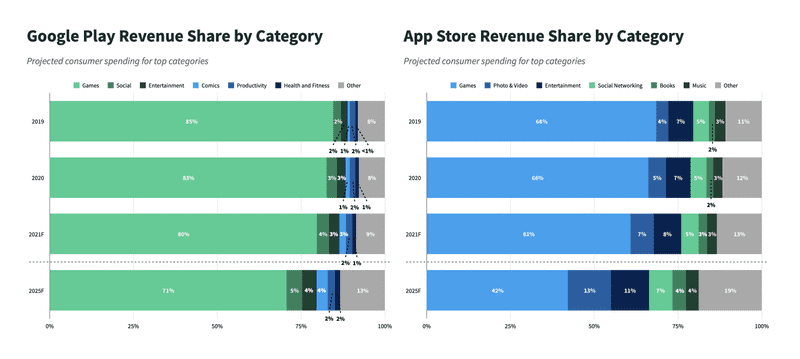
The popularity of online dating apps among users will continue to grow over the next few years. In terms of revenue, consumers spent more than $ 3 billion on dating apps in 2020, seeing a total of 560 million dating app downloads. The most popular monetization strategy used in dating apps is in-app purchases, especially in-app subscriptions. A good example of a subscription-based app is Tinder, which has generated $ 1.4 billion in both stores, making Tinder the most profitable non-gaming app of 2020. Here, Tinder is free to download, but it makes money by offering premium features such as additional likes and unlimited swipes on a monthly or annual subscription basis.
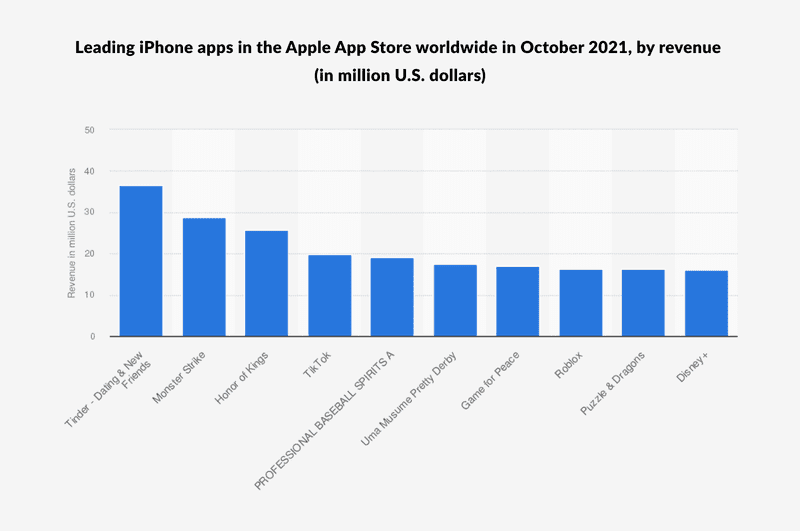
Entertainment apps. More and more people are choosing streaming services to meet their entertainment needs rather than paying for TV cable. These apps are thriving thanks to more direct and personalized experiences. Consumers in the United States installed an average of 9.5 video streaming apps on their mobile phones in 2021. This is an increase of 85% from 2019 as we are asking for more content options during the COVID 19 pandemic.
The two most popular entertainment apps in the first half of 2020 are TikTok and YouTube. Both apps have different monetization strategies and are still the top candidates for this niche. YouTube generated $ 564.7 million worldwide in the first half of 2021 and offers most of its content for free. YouTube makes money by sharing in-app ads and offering subscriptions to 2.3 billion monthly users. Meanwhile, TikTok uses a combination of advertising and in-app purchases to allow users to spend real money to buy TikTok coins and send virtual gifts to other users. With this strategy, TikTok became one of the top-selling apps in the first half of 2021 and generated $ 920 million in revenue.
The video and audio streaming apps are also popular in the entertainment category. Like YouTube, most video and audio streaming apps such as Netflix and Spotify generate revenue from subscription and ad usage, generating up to $ 19 million and up to $ 21 million per month, respectively.
Spending on non-gaming apps continues to grow rapidly on both the App Store and Google Play. Non-gaming app store revenue is expected to exceed 2024 game revenue by a compound annual growth rate of 34.3%. Non-gaming revenue on Google Play lags behind App Store revenue but is still projected to grow by nearly 30% annually. COVID-19 had a different impact on each category in 2020. Enterprise app adoption surged in the spring of 2020 as workers turned to apps to facilitate the transition from home to work. Downloads are expected to return to pre-COVID-19 levels in the next few years, but some of these changes are expected to continue beyond 2025.
Things to consider when developing an app
Due to the number of apps that became successful over the years a lot of best practices and tips are proven to help gain the desired outcome for your app ideas. Here are some of our advice that you might take into consideration before developing an app:
- Define the purpose of the app and make a strategy. When it comes to how an app makes money, the purpose of the app plays a central role. A detailed understanding of the issues you are targeting, the software development services your app provides, the potential impact it has on the market, and how your app can help your customers and their needs.
- Combine multiple monetization methods. Don't limit yourself to one way to monetize your app. You can create a freemium model and at the same time connect to advertisements. The paid version is ad-free and has additional features.
- Analyze the competition. Performing competitive analysis can also help you make decisions about developing money-making apps. Insights help show which strategies favor similar applications and what profits they have made. This ultimately helps in the decision-making process. Fierce competition and competitor analysis in the market does more than just help highlight, feature, and design your application. Thorough research and knowledge of your competitors make it easy to find a monetization business plan for your application. All you need to do is ask yourself certain questions like how competitors are earning? How solid are their models? Is there any loophole that can turn into an opportunity for you?
- Explore different technologies. The set of technologies we deploy in our applications not only enhances the user experience and differentiates us from our competitors, but also contributes to the revenue of our mobile apps. In the traditional platform model for monetizing mobile business applications, developers are offered only 70% of the amount paid for mobile applications. In contrast, the blockchain-based application model provides 85% of the app's total revenue share.
- Discounts. This is a common marketing tool that is useful for all kinds of activities. Such methods are especially useful for increasing the average revenue of your app. People love discounts, even fictitious ones! Discounts can be made for holidays, first in-app purchases, and more. The only limitation is your own imagination.
- Stand out from the crowd. AppStore and Google Play offer users millions of apps. Your task is to stand out from the crowd! There are different methods to draw attention to your program; the easiest one is to use inner resources of the App Store and Google Play. Some examples are: choosing the right category, receiving positive reviews and ratings, making screenshots that demonstrate what your application promises users to do, etc.
- New users. Of course, you'll need a large user base for obtaining sufficient mobile app profits. Therefore, to grow your target audience, you need to be proactive in using all possible marketing tools.
- Continuous development. The app needs to please users and offer something new every day. Major news media apps are attracting users by allowing them to create their own content. Users can upload different stories, images, and videos to share with the community.
- Cost awareness. This is a very vague problem that every business faces, and app development is no exception. Fortunately, there is a fairly detailed answer to this question. App pricing can be difficult and confusing because most designers and developers make the mistake of pricing the various factors involved in creating an app incorrectly. This is why our team created Product Tunnel. It is very easy to use! You only have to answer a quick survey about your future project about the usability, features, customer types, etc., and the app will generate a cost estimate for your app.
Final thoughts
The answer for "How much money can an app make?" may not be very clear, but statistics on the revenue of various apps can help give you a general understanding. There are endless ways to make money from the mobile world.
The future of apps appears to be very bright, as technology does not seem to reduce its development pace. If you are interested in this world, you can find out about our picks for the Top technology trends for 2022.
MCRO's mission is to leverage its experience in mobile app development to support business growth. If you don't know how to create a great app, please contact us.
